Clues in the Data: The Role of Education in Adopting Technology That Enhances Sustainable Lifestyle Choices
Abstract
1. Introduction
2. Methods
2.1. Data
2.2. Analysis
2.2.1. Factor Analysis
2.2.2. Cluster Analysis
2.2.3. Additional Cluster Characteristics
3. Results
4. Discussion
Author Contributions
Funding
Institutional Review Board Statement
Informed Consent Statement
Data Availability Statement
Conflicts of Interest
References
- Monroe, M.C.; Plate, R.R.; Oxarart, A.; Bowers, A.; Chaves, W.A. Identifying effective climate change education strategies: A systematic review of the research. Environ. Educ. Res. 2017, 25, 791–812. [Google Scholar] [CrossRef]
- Kollmuss, A.; Agyeman, J. Mind the Gap: Why do people act environmentally and what are the barriers to pro-environmental behavior? Environ. Educ. Res. 2002, 8, 239–260. [Google Scholar] [CrossRef]
- Heimlich, J.E.; Ardoin, N.M. Understanding Behavior to Understand Behavior Change: A Literature Review. Environ. Educ. Res. 2008, 14, 215–237. [Google Scholar] [CrossRef]
- Monroe, M.C. Two avenues for encouraging conservation behaviors. Hum. Ecol. Rev. 2003, 10, 113–125. [Google Scholar]
- De Young, R. Expanding and evaluating motives for environmentally responsible behavior. J. Soc. Issues 2000, 56, 509–526. [Google Scholar] [CrossRef]
- Kaplan, S. Human nature and environmentally responsible behavior. J. Soc. Issues 2000, 56, 491–508. [Google Scholar] [CrossRef]
- Stern, P.C. Toward a coherent theory of environmentally significant behavior. J. Soc. Issues 2000, 56, 407–424. [Google Scholar] [CrossRef]
- Murtagh, N.; Gatersleben, B.; Uzzell, D. 20:60:20—Differences in Energy Behaviour and Conservation between and within Households with Electricity Monitors. PLoS ONE 2014, 9, e92019. [Google Scholar] [CrossRef]
- Wilson, C.; Hargreaves, T.; Hauxwell-Baldwin, R. Smart homes and their users: A systematic analysis and key challenges. Pers. Ubiquitous Comput. 2015, 19, 463–476. [Google Scholar] [CrossRef]
- Hargreaves, T.; Nye, M.; Burgess, J. Making energy visible: A qualitative field study of how householders interact with feedback from smart energy monitors. Energy Policy 2010, 38, 6111–6119. [Google Scholar] [CrossRef]
- Yang, R.; Newman, M.W. Learning from a learning thermostat: Lessons for intelligent systems for the home. In Proceedings of the 2013 ACM International Joint Conference on Pervasive and Ubiquitous Computing—UbiComp ’13, Zurich, Switzerland, 8–12 September 2013; p. 93. [Google Scholar] [CrossRef]
- Warner, L.A. Who conserves and who approves? Predicting water conservation intentions in urban landscapes with referent groups beyond the traditional ‘important others’. Urban For. Urban Green. 2021, 60, 127070. [Google Scholar] [CrossRef]
- Warner, L.A.; Chaudhary, A.K.; Rumble, J.N.; Lamm, A.J.; Momol, E. Using Audience Segmentation to Tailor Residential Irrigation Water Conservation Programs. J. Agric. Educ. 2017, 58, 313–333. [Google Scholar] [CrossRef]
- McKenzie-Mohr, D.; Schultz, P.W. Choosing Effective Behavior Change Tools. Soc. Mark. Q. 2014, 20, 35–46. [Google Scholar] [CrossRef]
- R Core Team. R: A Language and Environment for Statistical Computing. R Foundation for Statistical Computing. 2020. Available online: https://www.R-project.org (accessed on 1 March 2023).
- Revelle, W. Psych: Procedures for Psychological, Psychometric, and Personality Research; Northwestern University: Evanston, IL, USA, 2020; Available online: https://CRAN.R-project.org/package=psych (accessed on 1 March 2023).
- Smith, R. Audience Segmentation Techniques. Oxford Research Encyclopedia of Communication. Available online: https://oxfordre.com/communication/view/10.1093/acrefore/9780190228613.001.0001/acrefore-9780190228613-e-321 (accessed on 9 May 2023).
- Mouselimis, L. ClusterR: Gaussian Mixture Models, K-Means, Mini-Batch-Kmeans, K-Medoids and Affinity Propagation Clustering. 2020. Available online: https://CRAN.R-project.org/package=ClusterR (accessed on 1 March 2023).
- Pham, D.T.; Dimov, S.S.; Nguyen, C.D. Selection of K in K-means clustering. Proc. Inst. Mech. Eng. Part C J. Mech. Eng. Sci. 2005, 219, 103–119. [Google Scholar] [CrossRef]
- Brock, G.; Pihur, V.; Datta, S.; Datta, S. ClValid: An R Package for Cluster Validation. J. Stat. Softw. 2008, 25, 1–22. [Google Scholar] [CrossRef]
- Nieweglowski, L. Clv: Cluster Validation Techniques. 2020. Available online: https://CRAN.R-project.org/package=clv (accessed on 1 March 2023).
- Silge, J.; Robinson, D. tidytext: Text Mining and Analysis Using Tidy Data Principles in R. J. Open Source Softw. 2016, 1, 37. [Google Scholar] [CrossRef]
- Rogers, E.M. Diffusion Of Innovations, 4th ed.; Free Press: Los Angeles, CA, USA, 2010; Available online: http://rbdigital.oneclickdigital.com (accessed on 5 March 2023).
- Suh, D.; Khachatryan, H.; Rihn, A.; Dukes, M. Relating Knowledge and Perceptions of Sustainable Water Management to Preferences for Smart Irrigation Technology. Sustainability 2017, 9, 607. [Google Scholar] [CrossRef]
- Carrico, A.R.; Fraser, J.; Bazuin, J.T. Green with Envy: Psychological and Social Predictors of Lawn Fertilizer Application. Environ. Behav. 2013, 45, 427–454. [Google Scholar] [CrossRef]
- Fraser, J.C.; Bazuin, J.T.; Band, L.E.; Grove, J.M. Covenants, cohesion, and community: The effects of neighborhood governance on lawn fertilization. Landsc. Urban Plan. 2013, 115, 30–38. [Google Scholar] [CrossRef]
- Nassauer, J.I.; Wang, Z.; Dayrell, E. What will the neighbors think? Cultural norms and ecological design. Landsc. Urban Plan. 2009, 92, 282–292. [Google Scholar] [CrossRef]
- Hsu, C.-L.; Lin, J.C.-C. An empirical examination of consumer adoption of Internet of Things services: Network externalities and concern for information privacy perspectives. Comput. Hum. Behav. 2016, 62, 516–527. [Google Scholar] [CrossRef]
- Koo, C.; Chung, N.; Nam, K. Assessing the impact of intrinsic and extrinsic motivators on smart green IT device use: Reference group perspectives. Int. J. Inf. Manag. 2015, 35, 64–79. [Google Scholar] [CrossRef]
- Mani, Z.; Chouk, I. Drivers of consumers’ resistance to smart products. J. Mark. Manag. 2017, 33, 76–97. [Google Scholar] [CrossRef]
- Shin, J.; Park, Y.; Lee, D. Who will be smart home users? An analysis of adoption and diffusion of smart homes. Technol. Forecast. Soc. Chang. 2018, 134, 246–253. [Google Scholar] [CrossRef]
- Canhoto, A.I.; Arp, S. Exploring the Factors That Support Adoption and Sustained Use of Health and Fitness Wearables. J. Mark. Manag. 2017, 33, 32–60. [Google Scholar] [CrossRef]
- Davis, S.L.; Dukes, M.D. Irrigation scheduling performance by evapotranspiration-based controllers. Agric. Water Manag. 2010, 98, 19–28. [Google Scholar] [CrossRef]
- Dukes, M.D. Water conservation potential of landscape irrigation smart controllers. Trans. ASABE 2012, 55, 563–569. [Google Scholar] [CrossRef]
- Dukes, M.D. Two decades of smart irrigation controllers in U.S. landscape irrigation. Trans. ASABE 2020, 63, 1593–1601. [Google Scholar] [CrossRef]
- Mayer, P.; DeOreo, W.B. Improving urban irrigation efficiency by using weather-based “smart” controllers. Am. Water Work. Assoc. J. 2010, 102, 86. [Google Scholar] [CrossRef]
- McCready, M.S.; Dukes, M.D. Landscape irrigation scheduling efficiency and adequacy by various control technologies. Agric. Water Manag. 2011, 98, 697–704. [Google Scholar] [CrossRef]
- McCready, M.S.; Dukes, M.D.; Miller, G.L. Water conservation potential of smart irrigation controllers on St. Augustinegrass. Agric. Water Manag. 2009, 96, 1623–1632. [Google Scholar] [CrossRef]
- Morera, M.C.; Monaghan, P.F.; Dukes, M.D.; Breder, E. Predicting Satisfaction with Smart Irrigation Controllers and Their Long-Term Use among Homeowners in Central Florida. JAWRA J. Am. Water Resour. Assoc. 2017, 53, 929–943. [Google Scholar] [CrossRef]
- Endter-Wada, J.; Kurtzman, J.; Keenan, S.P.; Kjelgren, R.K.; Neale, C.M.U. Situational Waste in Landscape Watering: Residential and Business Water Use in an Urban Utah Community. JAWRA J. Am. Water Resour. Assoc. 2008, 44, 902–920. [Google Scholar] [CrossRef]
- Huang, P.; Lamm, A.; Dukes, M. Informing Extension Program Development through Audience Segmentation: Targeting High Water Users. J. Agric. Educ. 2016, 57, 60–74. [Google Scholar] [CrossRef]
- Syme, G.J.; Shao, Q.; Po, M.; Campbell, E. Predicting and understanding home garden water use. Landsc. Urban Plan. 2004, 68, 121–128. [Google Scholar] [CrossRef]
- Zhang, X.; Khachatryan, H. Investigating Homeowners’ Preferences for Smart Irrigation Technology Features. Water 2019, 11, 1996. [Google Scholar] [CrossRef]
- Khachatryan, H.; Suh, D.; Xu, W.; Useche, P.; Dukes, M.D. Towards sustainable water management: Preferences and willingness to pay for smart landscape irrigation technologies. Land Use Policy 2019, 85, 33–41. [Google Scholar] [CrossRef]
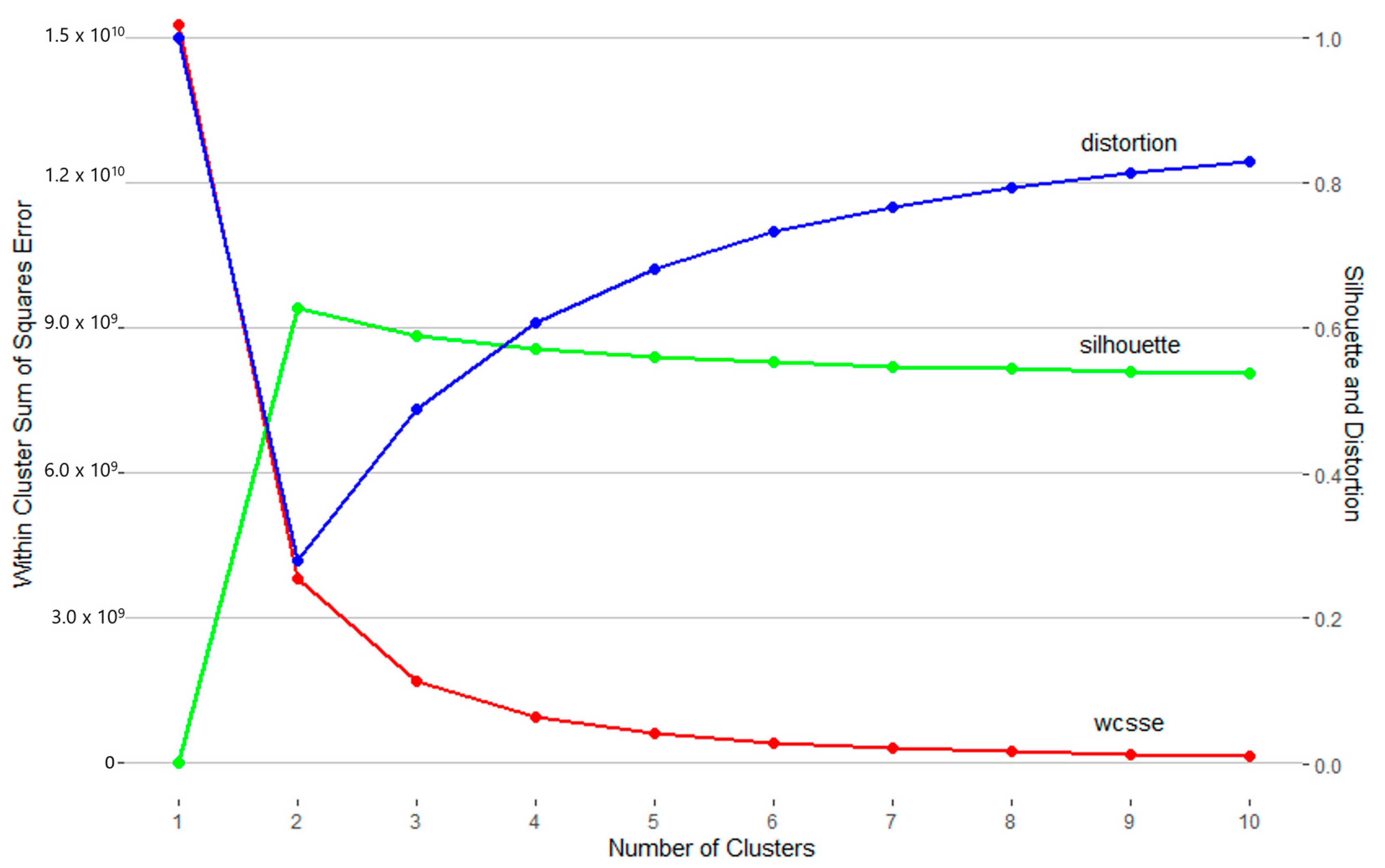
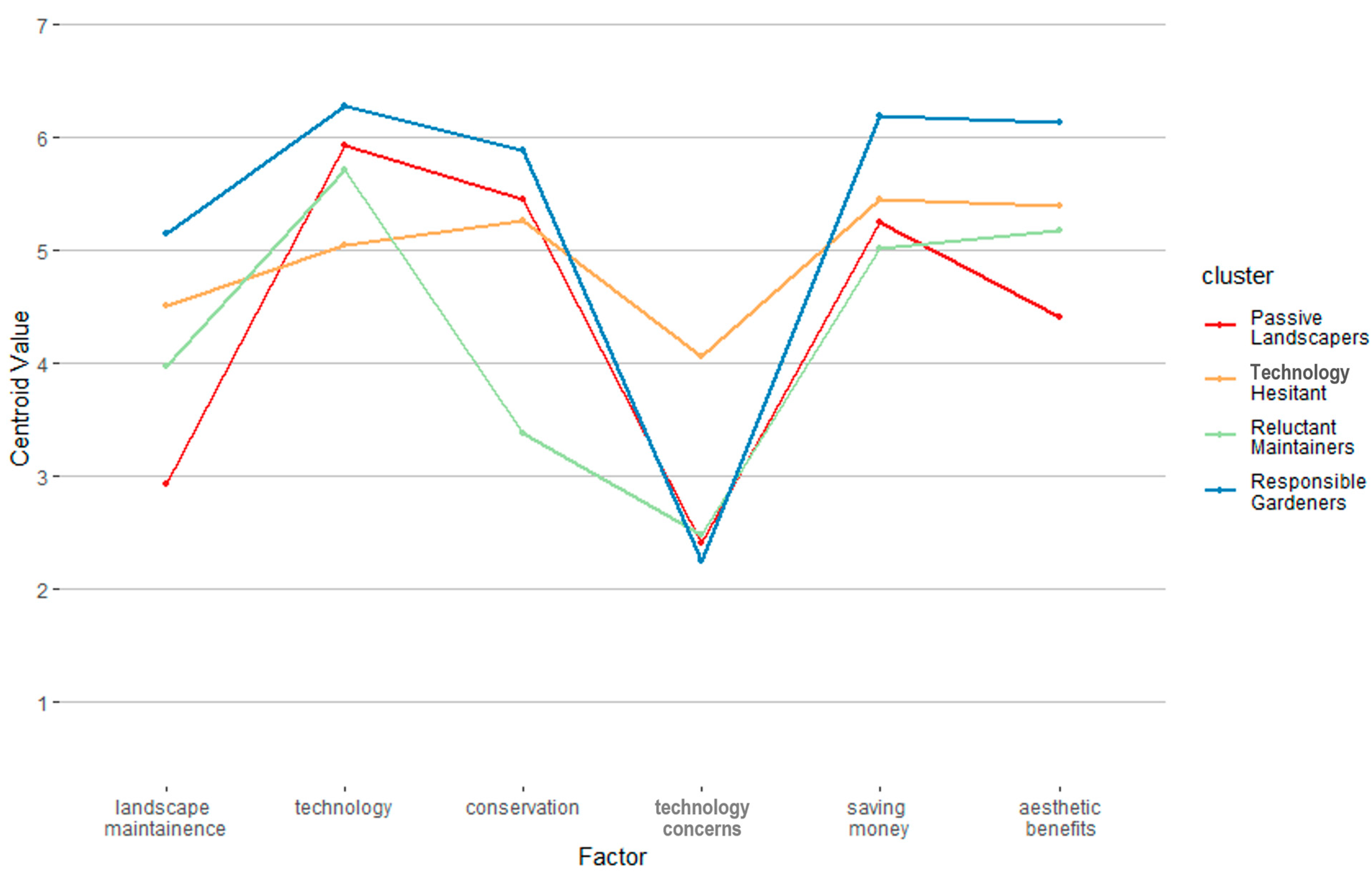
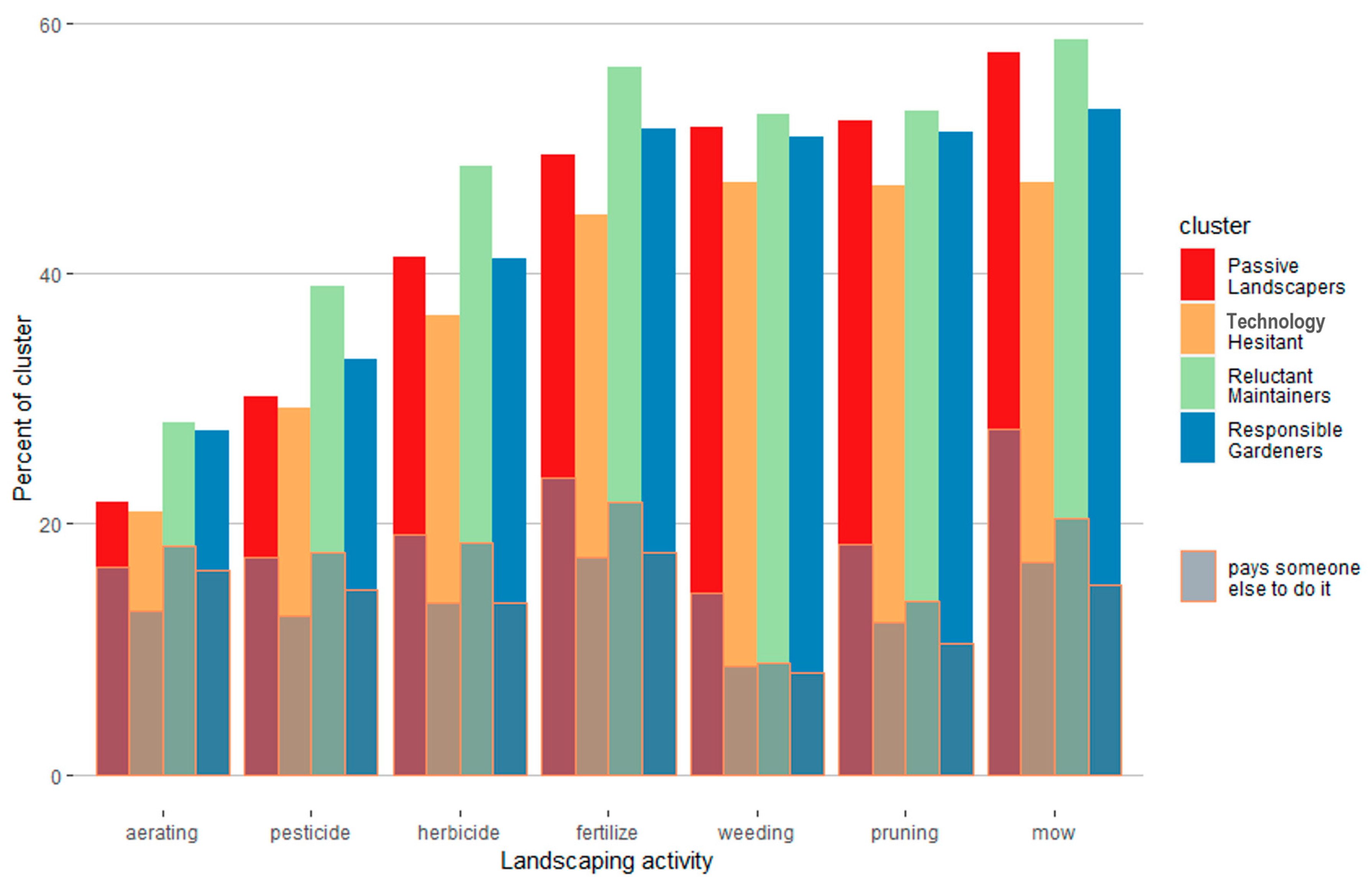
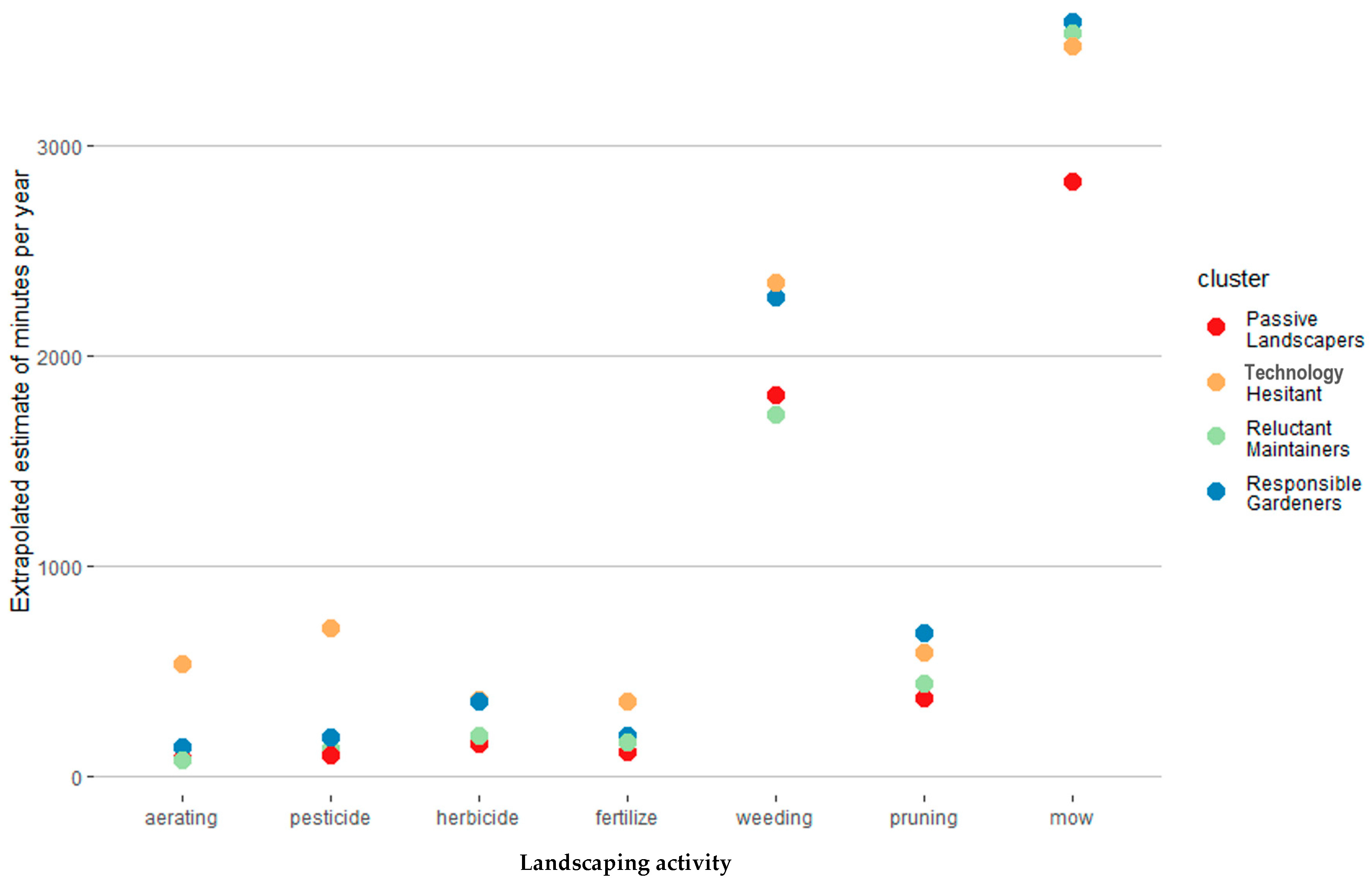
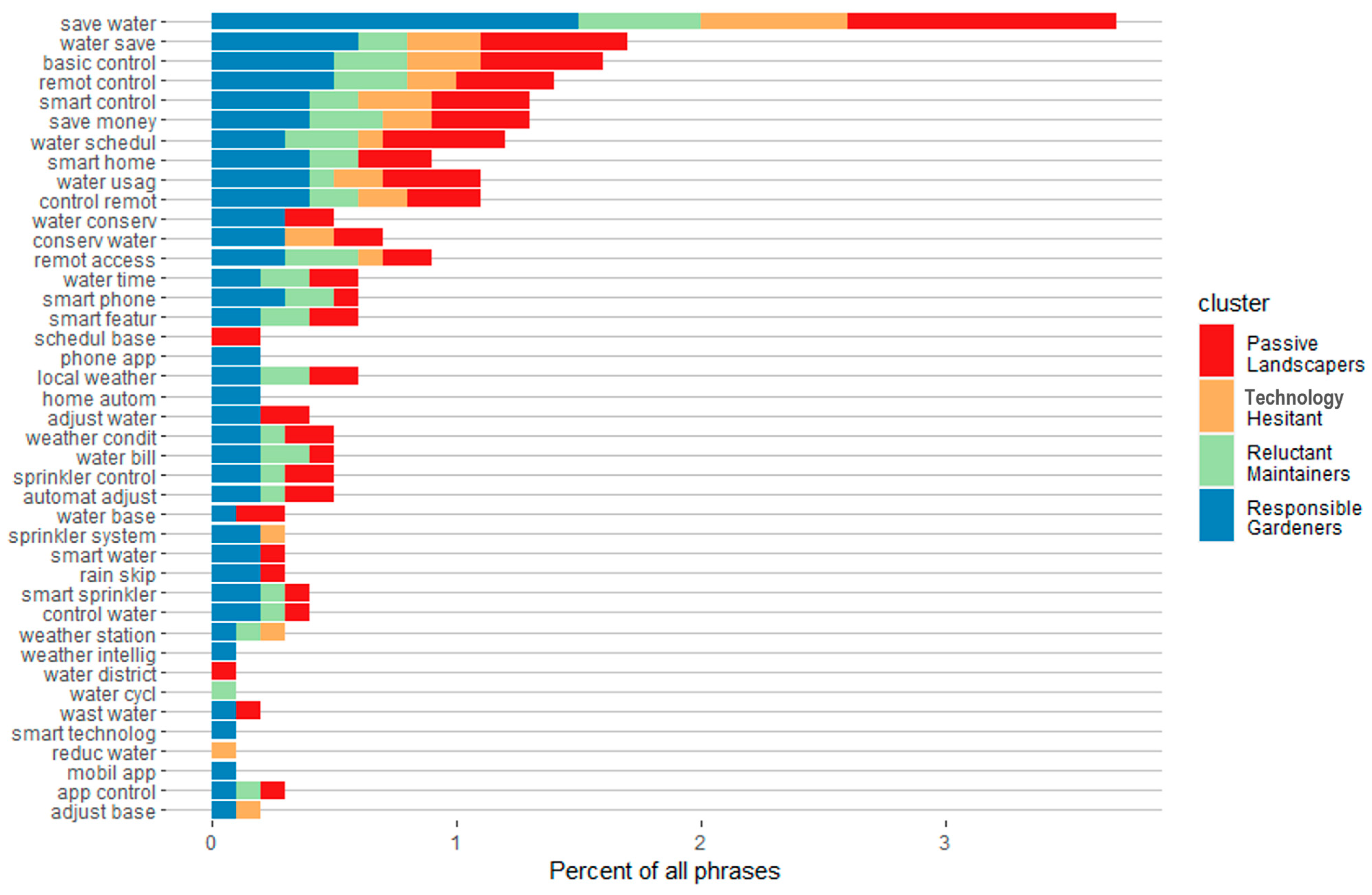
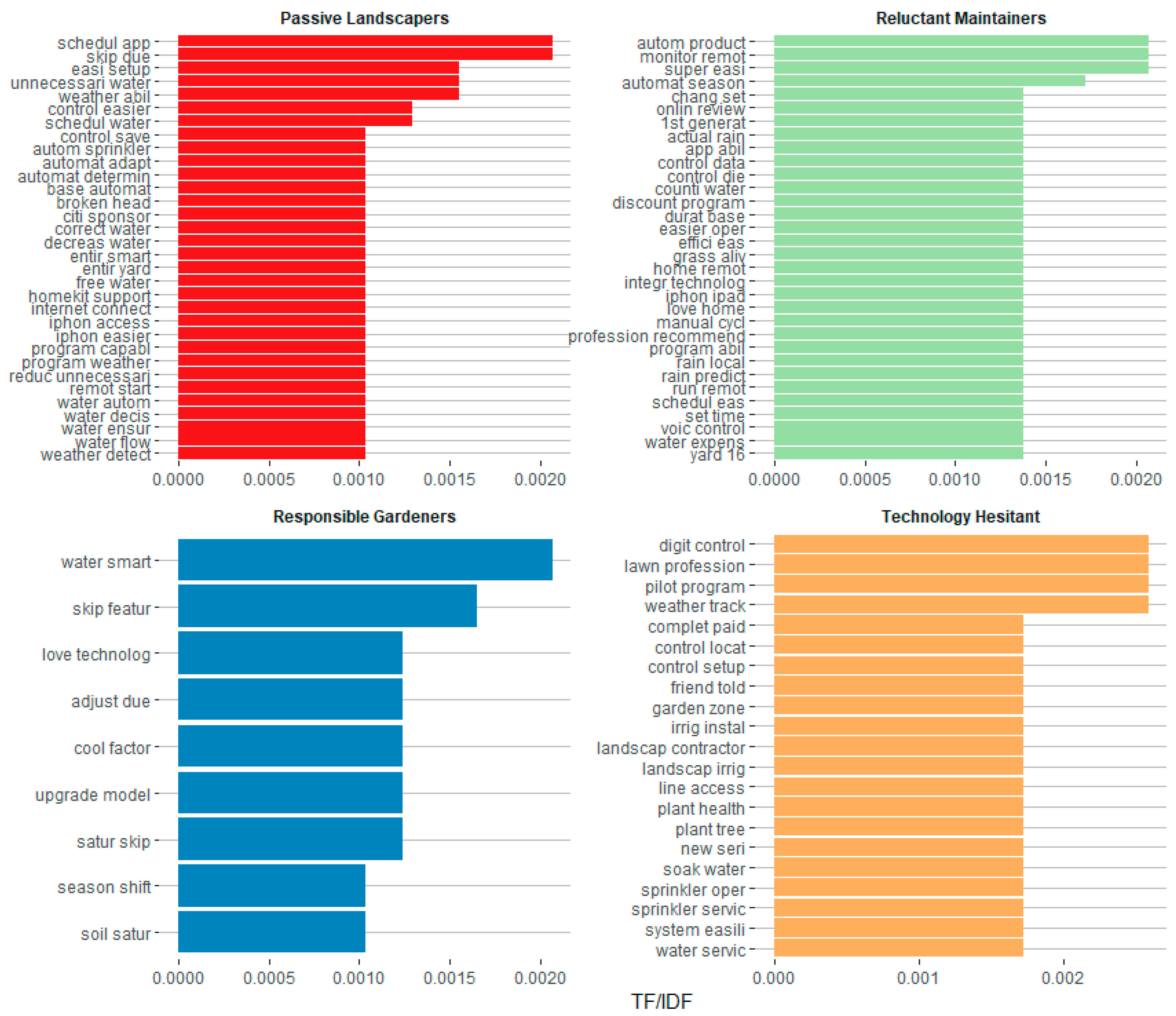
| Factor Eigenvalue | 1 3.37 | 2 3.10 | 3 2.79 | 4 2.21 | 5 1.56 | 6 1.54 | Cronbach’s Alpha |
|---|---|---|---|---|---|---|---|
| Maintaining my yard is my favorite hobby | 0.76 | 0.76 | |||||
| Maintaining my yard is relaxing | 0.74 | ||||||
| People often ask me for advice about their yards and landscaping | 0.66 | ||||||
| Maintaining my yard is a chore I dread * | −0.56 | ||||||
| I know everything I need to know to maintain my yard the way I want it | 0.50 | ||||||
| I try out new things in my landscaping every season | 0.43 | ||||||
| I wish I could maintain my yard with less work | −0.32 | ||||||
| I’m always looking for the latest and greatest technology | 0.76 | 0.80 | |||||
| I’m very interested in home automation and “smart home” technology | 0.72 | ||||||
| People often ask me advice about tech products | 0.67 | ||||||
| I’m excited about “smart home” technology | 0.63 | ||||||
| Technology and data could be helpful in improving my landscaping | 0.38 | ||||||
| The best part of technology is that it takes care of things so I don’t have to | 0.36 | ||||||
| I’m willing to invest in efforts to reverse climate change and help the environment | 0.83 | 0.83 | |||||
| I believe we all have a responsibility to conserve the earth’s natural resources | 0.78 | ||||||
| I’ll do anything I can to help protect the earth | 0.76 | ||||||
| Aside from the cost, wasting water at home has a major impact on the environment | 0.70 | ||||||
| No matter how much water I use at home, it won’t have an impact on large-scale environmental issues like drought * | −0.47 | ||||||
| A beautiful yard has a big impact on my home value | 0.63 | 0.79 | |||||
| Being able to enjoy a beautiful yard is a key part of my emotional well-being | 0.50 | ||||||
| Maintaining my yard gives me a great sense of accomplishment | 0.46 | ||||||
| My yard makes me proud | 0.42 | ||||||
| I want to have the best-looking yard in the neighborhood | 0.39 | ||||||
| I’m always looking for ways to save money on my utility bills | 0.77 | 0.64 | |||||
| It’s important for me to save money on water usage at home | 0.68 | ||||||
| I am very focused on increasing the value of my home | 0.32 | ||||||
| “Smart” products are too complicated | 0.64 | 0.67 | |||||
| New technology often frustrates me | 0.57 | ||||||
| I usually buy new technology only when my tried-and-true solutions don’t work any more | 0.41 | ||||||
| Most of the tech products I see are things I don’t need | 0.33 |
| Indicator | 2 Clusters | 3 Clusters | 4 Clusters |
|---|---|---|---|
| Davies–Bouldin | 1.57 | 1.57 | 1.50 |
| Dunn Index | 0.023 | 0.025 | 0.027 |
| Factor | Responsible Gardeners | Technology Hesitant | Reluctant Maintainers | Passive Landscapers |
|---|---|---|---|---|
| Interest in landscape maintenance | 4.35 | 3.87 | 3.5 | 2.57 |
| Interest in technology | 6.35 | 4.81 | 5.79 | 6.06 |
| Interest in conservation | 5.86 | 5.2 | 3.38 | 5.53 |
| Concerns about technology | 2.27 | 3.98 | 2.43 | 2.35 |
| Interest in saving money and increasing home value | 6.28 | 5.39 | 4.97 | 5.51 |
| Aesthetic benefits | 6.20 | 5.29 | 5.11 | 4.49 |
| Responsible Gardeners | Technology Hesitant | Reluctant Maintainers | Passive Landscapers | Statistic | |
|---|---|---|---|---|---|
| Age (mean/median) | 48.8/47 | 54.3/56 | 50.2/49 | 47.8/45 | F= 115.8, df = 3, p = 0.0 |
| Gender: Male Female Self-describe | 91.0% 8.7% 0.1% | 78.8% 19.5% 0.3% | 95.0% 4.4% 0.1% | 91.9% 7.4% 0.1% | Χ2 = 185.9, df = 3, p = 0.0 |
| Education: college graduate advanced degree | 46.4% 31.4% | 40.8% 41.7% | 46.7% 34.5% | 44.7% 37.4% | Χ2 = 26.7, df = 3, p = 0.0 |
| Location: California Texas Colorado midwest northeast south west | 24.1% 15.2% 9.8% 13.5% 9.2% 14.2% 14.1% | 27.6% 13.7% 9.2% 11.9% 7.8% 13.6% 16.2% | 20.9% 16.4% 8.1% 14.6% 9.0% 15.0% 15.9% | 28.7% 16.7% 8.9% 11.4% 6.5% 13.2% 14.7% | Χ2 = 16.1, df = 6, p = 0.01 Χ2 = 30.5, df = 12, p = 0.0 |
| Season length-months (mean) | 7.5 | 7.2 | 7.4 | 7.8 | |
| HOA | 50.1% | 46.3% | 51.0% | 50.3% | Χ2 = 6.6, df = 3, p = 0.08 |
| Other smart devices owned (mean, 0–9) | 5.0 | 3.1 | 4.8 | 4.8 | F = 224, df = 3, p = 0.0 |
| Yard size small <4000 ft2 med 4–10,000 ft2 med-large 10–22,000 ft2 | 18.6% 42.0% 22.7% | 24.6% 39.6% 20.3% | 19.0% 39.3% 25.0% | 27.5% 42.6% 19.1% | Χ2 = 48.1, df = 6, p = 0.0 |
| Years owned smart controller (mean) | 1.9 | 1.8 | 1.9 | 2.0 | |
| Engagement with app 2–4 x/week Once/week 2–3 x/month Once/month | 30.4% 26.6% 17.0% 14.9% | 23.5% 27.1% 16.8% 18.2% | 24.7% 28.8% 18.0% 18.6% | 16.0% 25.6% 22.5% 29.0% | Χ2 = 166.4, df = 9, p = 0.0 |
| Landscape maintenance num. of activities (mean, 1–7) hires out 75 + % of activities hours per year on maint. act. | 6.0 9.2% 109.4 | 5.2 11.5% 99.8 | 5.9 13.2% 83.5 | 5.2 19.9% 71.2 | |
| Appearance: equal importance front yard more important back yard more important | 67.7% 26.3% 6.0% | 63.5% 28.6% 7.9% | 57.7% 36.1% 6.2% | 55.1% 38.3% 6.6% | |
| Investment: equal investment front yard gets more back yard gets more | 62.7% 19.6% 17.6% | 60.3% 20.4% 19.3% | 59.2% 24.6% 16.2% | 54.8% 24.6% 20.6% |
| Responsible Gardeners | Technology Hesitant | Reluctant Maintainers | Passive Landscapers | All | |
|---|---|---|---|---|---|
| Total response | 1703 | 1112 | 1147 | 1333 | 5295 |
| 94.5% | 91.7% | 93.3% | 92.8% | 93.2% | |
| Words used (mean) | 12.4 | 9.8 | 11.6 | 12.5 | 11.7 |
| Most frequent words | control (n = 780) | control (n = 431) | control (n = 466) | water (n = 646) | control (n = 2309) |
| water (n = 768) | water (n = 370) | water (n = 401) | control (n = 632) | water (n = 2185) | |
| save (n = 285) | save (n = 139) | smart (n = 159) | save (n = 232) | save (n = 764) | |
| smart (n = 257) | weather (n = 104) | weather (n = 146) | weather (n = 205) | smart (n = 703) | |
| weather (n = 248) | smart (n = 97) | remote (n = 132) | smart (n = 190) | weather (n = 703) | |
| Most frequent phrase | save water (n = 203) | save water (n = 97) | save water (n = 64) | save water (n = 157) | save water (n = 521) |
| basic controller* (n = 55) | remote control (n = 41) | remote control (n = 51) | water schedule (n = 47) | remote control (n = 236) | |
| remote control (n = 83) | smart control (n = 38) | basic controller * (n = 29) | basic controller * (n = 44) | basic controller * (n = 160) | |
| smart home (n = 40) | basic controller * (n = 32) | water schedule (n = 28) | remote control (n = 38) | smart control (n = 123) | |
| save money (n = 36) | save money (n = 19) | save money (n = 23) | save money (n = 38) | save money (n = 116) |
Disclaimer/Publisher’s Note: The statements, opinions and data contained in all publications are solely those of the individual author(s) and contributor(s) and not of MDPI and/or the editor(s). MDPI and/or the editor(s) disclaim responsibility for any injury to people or property resulting from any ideas, methods, instructions or products referred to in the content. |
© 2023 by the authors. Licensee MDPI, Basel, Switzerland. This article is an open access article distributed under the terms and conditions of the Creative Commons Attribution (CC BY) license (https://creativecommons.org/licenses/by/4.0/).
Share and Cite
Komenda, S.; Monroe, M.C. Clues in the Data: The Role of Education in Adopting Technology That Enhances Sustainable Lifestyle Choices. Sustainability 2023, 15, 8443. https://doi.org/10.3390/su15118443
Komenda S, Monroe MC. Clues in the Data: The Role of Education in Adopting Technology That Enhances Sustainable Lifestyle Choices. Sustainability. 2023; 15(11):8443. https://doi.org/10.3390/su15118443
Chicago/Turabian StyleKomenda, Sara, and Martha C. Monroe. 2023. "Clues in the Data: The Role of Education in Adopting Technology That Enhances Sustainable Lifestyle Choices" Sustainability 15, no. 11: 8443. https://doi.org/10.3390/su15118443
APA StyleKomenda, S., & Monroe, M. C. (2023). Clues in the Data: The Role of Education in Adopting Technology That Enhances Sustainable Lifestyle Choices. Sustainability, 15(11), 8443. https://doi.org/10.3390/su15118443




